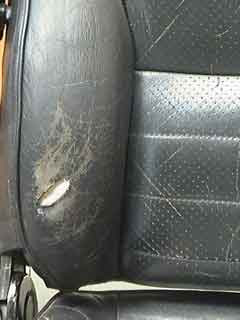How Much Does It Cost To Fix Thermostat In Car?
Fixing a car thermostat can seem daunting, but it’s often a straightforward repair. At CARDIAGTECH.NET, we understand the need for reliable auto repair information and tools. This guide will break down the costs involved, helping you keep your vehicle running smoothly with top-quality diagnostic tools and equipment. Explore our range of diagnostic tools and contact us at Whatsapp: +1 (641) 206-8880. You can also visit us at 276 Reock St, City of Orange, NJ 07050, United States, or visit our website CARDIAGTECH.NET for all your automotive repair needs. Discover the expense, labor, and materials.
1. Understanding the Car Thermostat
The car thermostat is a vital component of the engine’s cooling system. Its primary function is to regulate the engine’s temperature, ensuring it operates within an optimal range. When the engine is cold, the thermostat remains closed, preventing coolant from circulating through the radiator. This allows the engine to warm up quickly. Once the engine reaches its ideal operating temperature, the thermostat opens, allowing coolant to flow through the radiator, preventing overheating.
1.1. Why is the Thermostat Important?
A properly functioning thermostat ensures efficient engine operation, reduces wear and tear, and optimizes fuel economy. Without a thermostat, the engine may take too long to warm up or overheat, both of which can lead to significant engine damage.
1.2. Common Signs of a Faulty Thermostat
Recognizing the signs of a failing thermostat can save you from costly repairs down the road. Here are some common symptoms:
- Overheating Engine: This is one of the most obvious signs. If your engine temperature gauge consistently reads high, the thermostat might be stuck closed, preventing coolant from circulating.
- Engine Running Too Cold: If the thermostat is stuck open, the engine may not reach its optimal operating temperature, leading to decreased fuel efficiency and performance.
- Erratic Temperature Fluctuations: Sudden and unexplained changes in engine temperature can indicate a malfunctioning thermostat.
- Check Engine Light: A faulty thermostat can trigger the check engine light on your dashboard.
- Coolant Leaks: Leaks around the thermostat housing can also signal a problem.
2. Factors Influencing the Cost to Fix Thermostat in Car
Several factors can influence the cost of replacing a car thermostat. Understanding these elements will help you anticipate the expenses involved and make informed decisions.
2.1. Vehicle Make and Model
The make and model of your vehicle play a significant role in determining the cost of thermostat replacement. Luxury or high-performance vehicles often require more specialized parts and labor, leading to higher overall expenses. For instance, replacing a thermostat in a BMW or Mercedes-Benz may cost more than in a Toyota or Honda due to the complexity of the engine and cooling system design.
2.2. Type of Thermostat
Different types of thermostats are available, each with varying price points. Standard thermostats are generally more affordable, while electronic or high-performance thermostats can be more expensive. The type of thermostat your vehicle requires will depend on its specifications and performance needs.
2.3. Labor Costs
Labor costs can vary widely depending on the mechanic’s hourly rate and the complexity of the job. Thermostat replacement is typically a straightforward task, but accessibility can be an issue in some vehicles. If the thermostat is difficult to reach, it may require more time and effort, increasing labor costs.
2.4. Location
Geographic location also affects the cost of car repairs. Mechanics in urban areas or regions with a higher cost of living tend to charge more for labor than those in rural areas. Additionally, parts prices may vary depending on local suppliers and availability.
2.5. Additional Repairs
In some cases, thermostat replacement may reveal other underlying issues that need to be addressed. For example, if the cooling system is contaminated or corroded, it may be necessary to flush the system or replace other components, such as hoses or the water pump. These additional repairs will add to the overall cost.
3. Average Cost of Thermostat Replacement
So, How Much Does It Cost To Fix Thermostat In Car? The average cost to replace a car thermostat typically ranges from $150 to $400, including parts and labor. However, this is just an estimate, and the actual cost may vary depending on the factors mentioned above.
3.1. Parts Cost
The cost of a new thermostat can range from $20 to $100, depending on the type and brand. Standard thermostats are generally at the lower end of the price range, while electronic or high-performance thermostats can be more expensive.
3.2. Labor Cost
Labor costs typically range from $80 to $250, depending on the mechanic’s hourly rate and the complexity of the job. Most thermostat replacements take between one to two hours of labor.
3.3. Example Cost Breakdown
To illustrate, let’s consider a typical thermostat replacement for a standard sedan:
- Thermostat: $40
- Labor (2 hours at $100/hour): $200
- Total: $240
For a luxury vehicle, the costs could be higher:
- Thermostat: $80
- Labor (2.5 hours at $120/hour): $300
- Total: $380
4. DIY Thermostat Replacement vs. Professional Service
Deciding whether to replace the thermostat yourself or hire a professional is a crucial consideration. Both options have their pros and cons, and the best choice depends on your mechanical skills, available tools, and comfort level.
4.1. DIY Thermostat Replacement
Pros:
- Cost Savings: Doing it yourself can save you money on labor costs.
- Learning Experience: It can be a valuable learning experience for understanding your vehicle’s mechanics.
- Convenience: You can perform the repair at your own pace and schedule.
Cons:
- Risk of Mistakes: If you’re not familiar with car repairs, you could make mistakes that lead to further damage.
- Time Commitment: It can take several hours, especially if you’re a novice.
- Tool Requirements: You’ll need specific tools, which can be an additional expense if you don’t already own them.
- Safety Concerns: Working on your car can be dangerous if you don’t follow proper safety procedures.
Steps for DIY Thermostat Replacement:
- Gather Tools and Parts: You’ll need a new thermostat, socket set, wrench set, screwdrivers, pliers, a coolant drain pan, new coolant, and safety glasses.
- Drain the Coolant: Allow the engine to cool completely. Locate the radiator drain valve and place the drain pan underneath. Open the valve and drain the coolant.
- Locate the Thermostat Housing: The thermostat housing is usually located where the upper radiator hose connects to the engine.
- Remove the Thermostat Housing: Use a socket or wrench to remove the bolts or nuts securing the thermostat housing. Be careful not to damage the housing or surrounding components.
- Remove the Old Thermostat: Once the housing is removed, you can access the old thermostat. Take note of its orientation before removing it.
- Clean the Mating Surfaces: Use a scraper or wire brush to clean the thermostat housing and engine mating surfaces.
- Install the New Thermostat: Place the new thermostat in the housing with the correct orientation.
- Reassemble the Thermostat Housing: Install a new gasket or O-ring and reassemble the thermostat housing, tightening the bolts or nuts to the manufacturer’s specifications.
- Refill the Coolant: Close the radiator drain valve and refill the cooling system with the correct type and amount of coolant.
- Bleed the Cooling System: Start the engine and let it run for a few minutes with the radiator cap off to allow air to escape from the system. Monitor the coolant level and add more as needed.
- Check for Leaks: Inspect the thermostat housing and radiator hoses for any leaks.
4.2. Professional Thermostat Replacement
Pros:
- Expertise: Professional mechanics have the knowledge and experience to perform the repair correctly.
- Warranty: Most professional repairs come with a warranty, providing peace of mind.
- Time Savings: A mechanic can complete the job much faster than a DIYer.
- Proper Disposal: Mechanics will properly dispose of old parts and coolant.
Cons:
- Higher Cost: Labor costs can significantly increase the overall expense.
- Scheduling: You’ll need to schedule an appointment and may have to wait for the repair to be completed.
- Potential for Upselling: Some mechanics may try to upsell you on additional services or repairs.
Choosing Between DIY and Professional Service:
Consider the following factors when deciding whether to DIY or hire a professional:
- Your Mechanical Skills: Are you comfortable working on cars and do you have experience with similar repairs?
- Available Tools: Do you have the necessary tools or will you need to purchase them?
- Time Availability: Do you have the time to complete the repair, or do you need it done quickly?
- Budget: How much are you willing to spend on the repair?
- Risk Tolerance: Are you comfortable with the risk of making mistakes or causing further damage?
If you’re unsure about any of these factors, it’s best to consult with a professional mechanic.
5. Tips to Save Money on Thermostat Replacement
While thermostat replacement is a necessary repair, there are several ways to save money without compromising quality or safety.
5.1. Get Multiple Quotes
Before committing to a repair shop, get quotes from several different mechanics. This will give you a better idea of the average cost in your area and allow you to negotiate for a better price.
5.2. Use Reputable Aftermarket Parts
Consider using aftermarket parts from reputable brands. Aftermarket parts can be just as reliable as OEM (Original Equipment Manufacturer) parts but are often less expensive. Be sure to research the brand and read reviews before making a purchase.
5.3. Look for Discounts and Coupons
Many auto repair shops offer discounts or coupons for common services like thermostat replacement. Check their website, social media pages, or local coupon books for potential savings.
5.4. Bundle Repairs
If your vehicle needs other maintenance or repairs, consider bundling them together. Many mechanics offer discounts for multiple services performed at the same time. For example, if you’re getting your thermostat replaced, you might also consider getting a coolant flush or hose replacement.
5.5. Perform Preventative Maintenance
Regular preventative maintenance can help extend the life of your thermostat and other cooling system components. This includes flushing the cooling system according to the manufacturer’s recommendations, using the correct type of coolant, and inspecting hoses and connections for leaks.
6. Choosing the Right Mechanic
Selecting the right mechanic is crucial for ensuring a quality repair and avoiding unnecessary expenses. Here are some tips for finding a trustworthy and competent mechanic:
6.1. Ask for Recommendations
Ask friends, family, or colleagues for recommendations. Personal referrals can be a great way to find a reliable mechanic who has a proven track record.
6.2. Read Online Reviews
Check online review sites like Google, Yelp, or Angie’s List to see what other customers have to say about local mechanics. Pay attention to both positive and negative reviews, and look for patterns in the feedback.
6.3. Check for Certifications
Look for mechanics who are certified by organizations like the National Institute for Automotive Service Excellence (ASE). ASE certification indicates that the mechanic has met certain standards of knowledge and competence.
6.4. Inquire About Experience
Ask the mechanic about their experience with your vehicle make and model. Some mechanics specialize in certain types of vehicles, so it’s beneficial to find someone who is familiar with your car.
6.5. Get a Written Estimate
Before authorizing any repairs, get a written estimate that includes a breakdown of parts and labor costs. This will help you avoid surprises and ensure that you’re not being overcharged.
6.6. Ask Questions
Don’t hesitate to ask the mechanic questions about the repair process, parts being used, and any potential issues. A good mechanic will be happy to explain everything in detail and answer your concerns.
7. The Importance of a Properly Functioning Cooling System
Maintaining a healthy cooling system is essential for the longevity and performance of your vehicle. Overheating can cause severe engine damage, leading to expensive repairs or even engine failure.
7.1. Benefits of a Well-Maintained Cooling System
- Prevents Overheating: A properly functioning cooling system prevents the engine from overheating, which can cause damage to the head gasket, cylinder head, and other critical components.
- Maintains Optimal Engine Temperature: The cooling system ensures that the engine operates at its optimal temperature, which improves fuel efficiency and reduces emissions.
- Extends Engine Life: By preventing overheating and maintaining optimal temperature, the cooling system helps extend the life of the engine.
- Ensures Reliable Performance: A well-maintained cooling system ensures reliable performance, preventing breakdowns and keeping you on the road.
7.2. Common Cooling System Problems
In addition to a faulty thermostat, other common cooling system problems include:
- Coolant Leaks: Leaks can occur in hoses, the radiator, the water pump, or other cooling system components.
- Clogged Radiator: A clogged radiator can restrict coolant flow, leading to overheating.
- Faulty Water Pump: A failing water pump can reduce coolant circulation, causing the engine to overheat.
- Damaged Hoses: Cracked or deteriorated hoses can leak coolant and compromise the cooling system’s performance.
- Air in the Cooling System: Air pockets in the cooling system can reduce its efficiency and cause overheating.
7.3. Preventative Maintenance for the Cooling System
To keep your cooling system in top condition, follow these preventative maintenance tips:
- Flush the Cooling System: Flush the cooling system according to the manufacturer’s recommendations, typically every 30,000 to 50,000 miles.
- Use the Correct Coolant: Use the type of coolant specified in your vehicle’s owner’s manual.
- Check Coolant Level: Regularly check the coolant level in the radiator and overflow tank.
- Inspect Hoses and Connections: Inspect hoses and connections for leaks, cracks, or deterioration.
- Replace Worn Parts: Replace any worn or damaged cooling system components promptly.
- Pressure Test the System: Have the cooling system pressure tested periodically to check for leaks.
8. Using CARDIAGTECH.NET for Your Automotive Needs
At CARDIAGTECH.NET, we understand the challenges faced by auto repair professionals. The work is physically demanding, involves exposure to grease and chemicals, and requires continuous learning to keep up with new automotive technologies. That’s why we offer a wide range of high-quality diagnostic tools and equipment to enhance efficiency, accuracy, and safety in your work.
8.1. How CARDIAGTECH.NET Can Help
- Enhanced Efficiency: Our advanced diagnostic tools help you quickly identify and resolve issues, reducing repair time.
- Increased Accuracy: Precise diagnostic equipment ensures accurate assessments, preventing unnecessary repairs and saving costs for your customers.
- Improved Safety: High-quality tools and equipment enhance safety during repairs, protecting both you and the vehicle.
- Cost Savings: By improving efficiency and accuracy, our tools help reduce labor costs and minimize the need for repeat repairs.
- Customer Satisfaction: Providing accurate and efficient service enhances customer satisfaction and builds trust in your expertise.
8.2. Featured Products
- Diagnostic Scanners: Advanced scanners for comprehensive vehicle diagnostics.
- OBD-II Code Readers: Easy-to-use code readers for quick identification of trouble codes.
- Multimeters: Versatile multimeters for electrical testing and diagnostics.
- Cooling System Pressure Testers: Reliable pressure testers for detecting leaks in the cooling system.
- Thermometers: Accurate thermometers for measuring engine temperature.
8.3. Why Choose CARDIAGTECH.NET?
- High-Quality Products: We offer only the highest quality tools and equipment from trusted brands.
- Competitive Pricing: Our products are priced competitively to provide the best value for your investment.
- Expert Support: Our team of experts is available to provide technical support and answer your questions.
- Fast Shipping: We offer fast and reliable shipping to get you the tools you need quickly.
- Customer Satisfaction: We are committed to providing excellent customer service and ensuring your satisfaction.
8.4. Contact Us
Ready to enhance your auto repair capabilities? Contact CARDIAGTECH.NET today.
- Address: 276 Reock St, City of Orange, NJ 07050, United States
- WhatsApp: +1 (641) 206-8880
- Website: CARDIAGTECH.NET
Let CARDIAGTECH.NET be your partner in delivering top-quality auto repairs. Contact us today to learn more about our products and how they can benefit your business.
9. Real-World Examples
To further illustrate the costs involved in thermostat replacement, let’s look at a few real-world examples.
9.1. Example 1: 2015 Honda Civic
- Problem: Overheating engine and check engine light.
- Diagnosis: Faulty thermostat.
- Parts: Standard thermostat ($35).
- Labor: 1.5 hours at $100/hour ($150).
- Total Cost: $185.
9.2. Example 2: 2018 Ford F-150
- Problem: Engine running too cold and poor fuel economy.
- Diagnosis: Thermostat stuck open.
- Parts: Standard thermostat ($45).
- Labor: 2 hours at $110/hour ($220).
- Total Cost: $265.
9.3. Example 3: 2016 BMW 328i
- Problem: Erratic temperature fluctuations and coolant leak.
- Diagnosis: Faulty thermostat and damaged thermostat housing.
- Parts: Electronic thermostat ($80) and thermostat housing ($60).
- Labor: 2.5 hours at $120/hour ($300).
- Total Cost: $440.
These examples demonstrate the range of costs you might encounter when replacing a thermostat, depending on the vehicle and the specific issues involved.
10. Why Choose Professional-Grade Tools?
Investing in professional-grade diagnostic tools and equipment from CARDIAGTECH.NET can significantly improve the efficiency and accuracy of your auto repair services. These tools are designed to withstand the demands of daily use and provide reliable performance, ensuring that you can quickly and effectively diagnose and repair vehicle issues.
10.1. Durability and Reliability
Professional-grade tools are built to last, with durable materials and robust construction. This ensures that they can withstand the rigors of daily use in a busy auto repair shop.
10.2. Accuracy and Precision
High-quality diagnostic tools provide accurate and precise readings, allowing you to quickly identify the root cause of vehicle problems. This reduces the risk of misdiagnosis and ensures that you’re performing the right repairs.
10.3. Time Savings
With professional-grade tools, you can diagnose and repair vehicle issues more quickly and efficiently. This saves you time and allows you to serve more customers.
10.4. Enhanced Safety
High-quality tools and equipment enhance safety during repairs, protecting both you and the vehicle. This reduces the risk of accidents and injuries in the workplace.
10.5. Customer Satisfaction
By providing accurate and efficient service, you can enhance customer satisfaction and build trust in your expertise. This leads to repeat business and positive word-of-mouth referrals.
11. Addressing Customer Challenges with CARDIAGTECH.NET
We understand the unique challenges faced by auto repair professionals, including the physical demands of the job, exposure to harsh chemicals, and the constant need to update skills and knowledge. CARDIAGTECH.NET is committed to providing solutions that address these challenges and help you succeed in your profession.
11.1. Enhancing Efficiency
Our advanced diagnostic tools are designed to streamline the repair process, reducing the time and effort required to diagnose and fix vehicle issues. This allows you to complete more repairs in less time, increasing your productivity and profitability.
11.2. Ensuring Accuracy
Precise diagnostic equipment ensures accurate assessments, preventing unnecessary repairs and saving costs for your customers. This builds trust and enhances your reputation as a reliable and competent mechanic.
11.3. Promoting Safety
High-quality tools and equipment enhance safety during repairs, protecting both you and the vehicle. This reduces the risk of accidents and injuries in the workplace, creating a safer and more productive environment.
11.4. Providing Support
Our team of experts is available to provide technical support and answer your questions, ensuring that you have the knowledge and resources you need to succeed. We are committed to being your partner in delivering top-quality auto repairs.
12. Conclusion: Invest in Quality and Expertise
Determining How Much Does It Cost To Fix Thermostat In Car depends on several factors, including the vehicle’s make and model, the type of thermostat, labor costs, and geographic location. While DIY thermostat replacement can save money, it’s essential to consider the risks and potential for mistakes. Hiring a professional mechanic ensures a quality repair and provides peace of mind.
To enhance your auto repair capabilities, invest in professional-grade diagnostic tools and equipment from CARDIAGTECH.NET. Our high-quality products, competitive pricing, and expert support will help you deliver efficient, accurate, and safe auto repair services. Contact us today to learn more and take your business to the next level.
13. Frequently Asked Questions (FAQ)
1. What is a car thermostat and what does it do?
A car thermostat is a valve that regulates the flow of coolant through the engine. It helps the engine warm up quickly and maintains a consistent operating temperature to prevent overheating.
2. How do I know if my car thermostat is bad?
Common symptoms include overheating engine, engine running too cold, erratic temperature fluctuations, check engine light, and coolant leaks.
3. Can I drive my car with a bad thermostat?
It’s not recommended. A bad thermostat can cause overheating or poor engine performance, leading to further damage.
4. How long does it take to replace a car thermostat?
Most thermostat replacements take between one to two hours.
5. Can I replace the thermostat myself?
If you have mechanical skills and the necessary tools, you can replace the thermostat yourself. However, if you’re unsure, it’s best to hire a professional.
6. How much does a new thermostat cost?
The cost of a new thermostat ranges from $20 to $100, depending on the type and brand.
7. How much does it cost to have a mechanic replace the thermostat?
Labor costs typically range from $80 to $250, depending on the mechanic’s hourly rate and the complexity of the job.
8. What is the average total cost for thermostat replacement?
The average total cost ranges from $150 to $400, including parts and labor.
9. Are there any other repairs I should consider when replacing the thermostat?
Consider a coolant flush, hose replacement, or water pump replacement if they are due for maintenance or show signs of wear.
10. Why should I choose professional-grade tools from CARDIAGTECH.NET?
Professional-grade tools from CARDIAGTECH.NET offer durability, accuracy, time savings, enhanced safety, and increased customer satisfaction.
This comprehensive guide should give you a clear understanding of the costs involved in fixing a car thermostat and the importance of maintaining a healthy cooling system. Remember to contact CARDIAGTECH.NET for all your automotive diagnostic tool needs.







